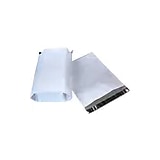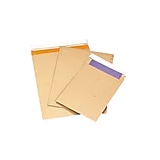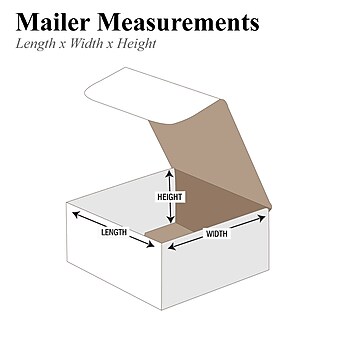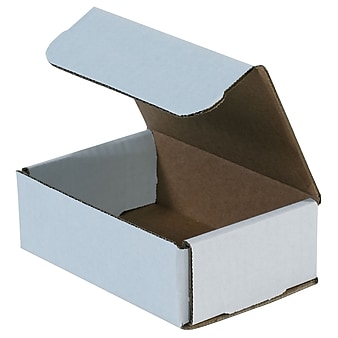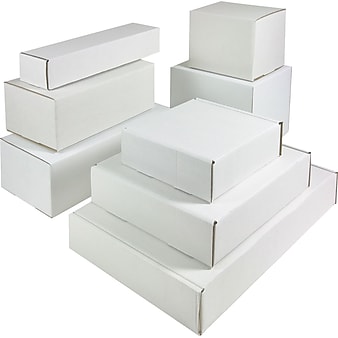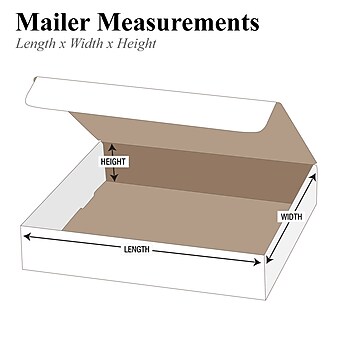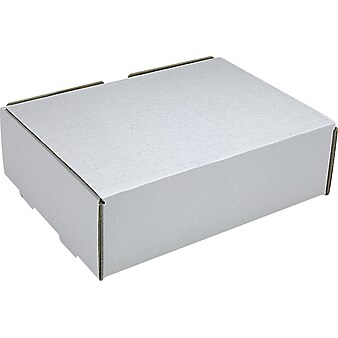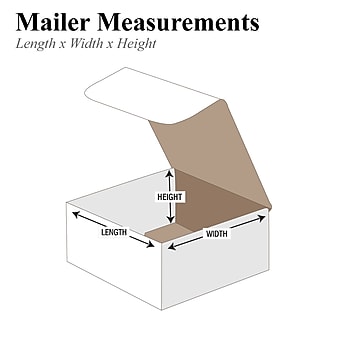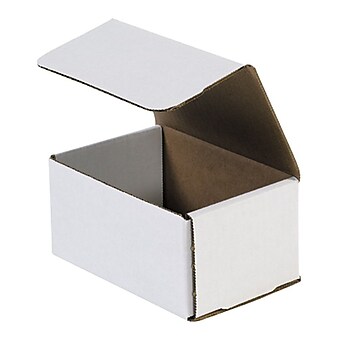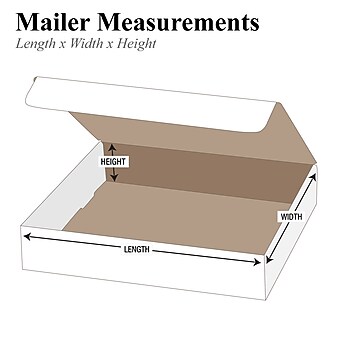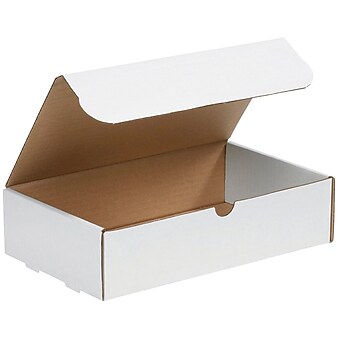Corrugated Mailers
Best Match
List view
Pick up and Delivery
Brand
Corrugated Mailer Type
Corrugate Length (Inches)
Corrugate Height (Inches)
Corrugate Width (Inches)
Item # : 558941
Model # : M642
Partners Brand Corrugated Mailers are super strong yet light-weight to save on postage.
- Front locking tabs won't interfere with contents and provide a secure closure
- Folds together in seconds, no tape needed
Price is $36.29
Unit of measure 50/Carton
1
1
2
3
4
5
6
7
8
9
10
11
12
13
14
15
16
17
18
19
20
21
22
23
24
25
26
27
28
29
30
Over 30
Item # : 1578411
Model # : MFL18126
The Partners Brand MFL18126 oyster white 6" x 18" deluxe literature mailers is an economical option to efficiently ship and store all your important documents.
- Product Type: Literature Mailers
- Oyster white colored corrugated construction
Price is $181.19
Unit of measure 25/Bundle
1
1
2
3
4
5
6
7
8
9
10
11
12
13
14
15
16
17
18
19
20
21
22
23
24
25
26
27
28
29
30
Over 30
Item # : 948954
Model # : M36241
This one-piece Jumbo Fold-Over Mailer is great for oversized flat items like portfolios, maps and blue prints.
- Dimensions: 36" x 24" x 1"
- Mailer fully opens for easy packing, and simply lay product on the flat mailer, fold in and seal with tape
Price is $169.49
Unit of measure 20/Bundle
1
1
2
3
4
5
6
7
8
9
10
11
12
13
14
15
16
17
18
19
20
21
22
23
24
25
26
27
28
29
30
Over 30
Item # : 949002
Model # : M1BKSS
With Partners Brand Deluxe Easy-Fold Mailer, peel and seal closure secures mailers without the need for tape or glue.
- Dimensions: 11 1/8" x 8 5/8" x 2"
- One-piece mailer has scores at multiple depths to ensure the proper fit for your products
Price is $183.59
Unit of measure 25/Bundle
1
1
2
3
4
5
6
7
8
9
10
11
12
13
14
15
16
17
18
19
20
21
22
23
24
25
26
27
28
29
30
Over 30
Item # : 630472
Model # : MFL18124
Partners Brand Deluxe Literature Mailers feature protective side flaps and front outside tuck closure.
- Folds together in seconds, no tape needed
- Strong 200#/ECT-32B white corrugated construction
Price is $114.89
Unit of measure 25/Bundle
1
1
2
3
4
5
6
7
8
9
10
11
12
13
14
15
16
17
18
19
20
21
22
23
24
25
26
27
28
29
30
Over 30
Item # : 426748
Model # : M622
Partners Brand Corrugated Mailers are super strong yet light-weight to save on postage.
- Corrugated mailers are perfect for shipping small, light-weight fragile items
- Corrugated Mailers are manufactured from 200#/ECT-32-B oyster white corrugated
Price is $24.69
Unit of measure 50/Bundle
1
1
2
3
4
5
6
7
8
9
10
11
12
13
14
15
16
17
18
19
20
21
22
23
24
25
26
27
28
29
30
Over 30
Item # : 949031
Model # : M13104
Partners Brand Literature Mailers are the perfect fit for your literature piece without the expense of a custom carton.
- The perfect fit for your literature piece without the expense of a custom carton.
- Assembles in seconds without tape, glue or staples.
Price is $157.99
Unit of measure 50/Bundle
1
1
2
3
4
5
6
7
8
9
10
11
12
13
14
15
16
17
18
19
20
21
22
23
24
25
26
27
28
29
30
Over 30
Item # : 414173
Model # : M962
Staples Corrugated mailer in white color measures 9" x 6 1/2" x 2 3/4" and offers ample storage space.
- Folds together in seconds, no tape needed
- Strong 200#/ECT-32B white corrugated construction
Price is $60.19
Unit of measure 50/Carton
1
1
2
3
4
5
6
7
8
9
10
11
12
13
14
15
16
17
18
19
20
21
22
23
24
25
26
27
28
29
30
Over 30
Item # : 559028
Model # : M742
Partners Brand Corrugated Mailers are super strong yet light-weight to save on postage.
- Corrugated Mailers are super strong yet light-weight to save on postage.
- Perfect for shipping small, light-weight fragile items.
Price is $54.19
Unit of measure 50/Bundle
1
1
2
3
4
5
6
7
8
9
10
11
12
13
14
15
16
17
18
19
20
21
22
23
24
25
26
27
28
29
30
Over 30
Item # : 947466
Model # : M961K
Partners Brand Kraft Easy-Fold Mailer has economical kraft construction that helps reduce mailing costs.
- Economical kraft construction helps reduce mailing costs.
- These one-piece mailers have scores at multiple depths to ensure the proper fit for your products. Multi-depth dimensions: 5/8”, 1-1/4”
Price is $54.69
Unit of measure 50/Bundle
1
1
2
3
4
5
6
7
8
9
10
11
12
13
14
15
16
17
18
19
20
21
22
23
24
25
26
27
28
29
30
Over 30
Item # : 947423
Model # : M12122K
Partners Brand Kraft Easy-Fold Mailer has economical kraft construction that helps reduce mailing costs.
- Economical kraft construction helps reduce mailing costs.
- These one-piece mailers have scores at multiple depths to ensure the proper fit for your products.
Price is $108.29
Unit of measure 50/Bundle
1
1
2
3
4
5
6
7
8
9
10
11
12
13
14
15
16
17
18
19
20
21
22
23
24
25
26
27
28
29
30
Over 30
Item # : 559027
Model # : M643
Corrugated Mailers are super strong yet light-weight to save on postage.
- Front locking tabs won't interfere with contents and provide a secure closure
- Folds together in seconds, no tape needed
Price is $41.39
Unit of measure 50/Bundle
1
1
2
3
4
5
6
7
8
9
10
11
12
13
14
15
16
17
18
19
20
21
22
23
24
25
26
27
28
29
30
Over 30
Item # : 946853
Model # : MCC1
Use this easy-to-carry Partners Brand Corrugated Carrying Case, when you are on the go.
- Use these easy-to-carry cases when you are on the go.
- Great for transporting products, promotional materials, samples or literature.
Price is $41.89
Unit of measure 10/Bundle
1
1
2
3
4
5
6
7
8
9
10
11
12
13
14
15
16
17
18
19
20
21
22
23
24
25
26
27
28
29
30
Over 30
Item # : 1499870
Model # : M632K
Partners Brand 6" x 3" x 2" Corrugated Mailers - Ideal for shipping small, lightweight fragile items
- Material: Kraft Corrugated
- Dimension: 6"H x 3"W x 2"D
Price is $42.89
Unit of measure 50/Bundle
1
1
2
3
4
5
6
7
8
9
10
11
12
13
14
15
16
17
18
19
20
21
22
23
24
25
26
27
28
29
30
Over 30
Item # : 948951
Model # : M201614
This one-piece Jumbo Fold-Over Mailer is great for oversized flat items like portfolios, maps and blue prints.
- Mailer fully opens for easy packing, and simply lay product on the flat mailer, fold in and seal with tape
- Attractive 200#/ECT-32-B white corrugated construction makes an impressive presentation
Price is $58.89
Unit of measure 20/Bundle
1
1
2
3
4
5
6
7
8
9
10
11
12
13
14
15
16
17
18
19
20
21
22
23
24
25
26
27
28
29
30
Over 30

Buy More, Save More of The Packaging Wholesalers 5-13/16" x 5" x 1/2" CD Jewel Case Corrugated Mailer, Holds 1 CD
Item # : 2647435
Model # : MLRCD
- Outside tuck won’t interfere with contents
- Front lock tabs provide secure closure
Price is $65.79
Unit of measure 50/Bundle
1
1
2
3
4
5
6
7
8
9
10
11
12
13
14
15
16
17
18
19
20
21
22
23
24
25
26
27
28
29
30
Over 30
Item # : 947432
Model # : M17112BFK
Partners Brand Kraft Easy-Fold Mailer has economical kraft construction that helps reduce mailing costs.
- These one-piece mailers have scores at multiple depths to ensure the proper fit for your products. Multi-depth dimensions: ½”, 1”, 1-1/2”, 2”
- Simply place product in the center, fold in the sides at your desired depth and seal with tape
Price is $130.59
Unit of measure 50/Bundle
1
1
2
3
4
5
6
7
8
9
10
11
12
13
14
15
16
17
18
19
20
21
22
23
24
25
26
27
28
29
30
Over 30
Item # : 558923
Model # : M732
Partners Brand Corrugated Mailers are super strong yet light-weight to save on postage.
- Front locking tabs won't interfere with contents and provide a secure closure
- Folds together in seconds, no tape needed
Price is $37.69
Unit of measure 50/Bundle
1
1
2
3
4
5
6
7
8
9
10
11
12
13
14
15
16
17
18
19
20
21
22
23
24
25
26
27
28
29
30
Over 30
Item # : 2301198
Model # : M1222
Corrugated Mailers are super strong yet light-weight to save on postage.
- Corrugated Mailers are super strong yet light-weight to save on postage.
- Perfect for shipping small, light-weight fragile items.
Price is $44.29
Unit of measure 50/Bundle
1
1
2
3
4
5
6
7
8
9
10
11
12
13
14
15
16
17
18
19
20
21
22
23
24
25
26
27
28
29
30
Over 30
Item # : 2301495
Model # : M36366
Jumbo mailers in hard-to-find sizes.
- Jumbo mailers in hard-to-find sizes.
- Great for shipping framed posters or artwork.
Price is $375.39
Unit of measure 20/Bundle
1
1
2
3
4
5
6
7
8
9
10
11
12
13
14
15
16
17
18
19
20
21
22
23
24
25
26
27
28
29
30
Over 30


Buy More, Save More of Partners Brand Corrugated Mailers, 11 1/8" x 8 3/4" x 2 5/16", White, 50/Bundle (M1182D)
Item # : 414165
Model # : M1182D
Partners Brand Literature Mailers are the perfect fit for your literature piece without the expense of a custom carton.
- Literature Mailers are the perfect fit for any literature piece
- Strong 200#/ECT-32-B oyster white corrugated construction
Price is $88.19
Unit of measure 50/Bundle
1
1
2
3
4
5
6
7
8
9
10
11
12
13
14
15
16
17
18
19
20
21
22
23
24
25
26
27
28
29
30
Over 30
Item # : 24323803
Model # : MRX6XK
Kraft Corrugated Mailers are light-weight to save on postage.
- Perfect for shipping small, light-weight fragile items.
- Corrugated Mailers are manufactured from 200#
Price is $59.49
Unit of measure 50/Bundle
1
1
2
3
4
5
6
7
8
9
10
11
12
13
14
15
16
17
18
19
20
21
22
23
24
25
26
27
28
29
30
Over 30
Item # : 1578446
Model # : M752BF
The Partners Brand M752BF white 2" x 7.5" corrugated bookfolds provides a smart way to ship and store all your important documents in the easiest way possible.
- Product Type: Corrugated Bookfolds
- White colored corrugated construction
Price is $57.19
Unit of measure 50/Bundle
1
1
2
3
4
5
6
7
8
9
10
11
12
13
14
15
16
17
18
19
20
21
22
23
24
25
26
27
28
29
30
Over 30
Item # : 558894
Model # : M322
Partners Brand Corrugated Mailers are super strong yet light-weight to save on postage.
- 3" x 2" x 2"
- Front locking tabs won't interfere with contents and provide a secure closure
Price is $32.89
Unit of measure 50/Bundle
1
1
2
3
4
5
6
7
8
9
10
11
12
13
14
15
16
17
18
19
20
21
22
23
24
25
26
27
28
29
30
Over 30
Item # : 947453
Model # : M853
White Crush-Proof Corrugated Mailer is super strong yet light-weight to save on postage.
- Corrugated Mailers are super strong yet light-weight to save on postage.
- Perfect for shipping small, light-weight fragile items.
Price is $93.69
Unit of measure 50/Bundle
1
1
2
3
4
5
6
7
8
9
10
11
12
13
14
15
16
17
18
19
20
21
22
23
24
25
26
27
28
29
30
Over 30
Item # : 414168
Model # : M1292
Partners Brand Literature Mailers are the perfect fit for your literature piece without the expense of a custom carton.
- 12-1/8" x 9-1/4" x 2"
- Folds together in seconds, no tape needed
Price is $67.99
Unit of measure 50/Bundle
1
1
2
3
4
5
6
7
8
9
10
11
12
13
14
15
16
17
18
19
20
21
22
23
24
25
26
27
28
29
30
Over 30
Item # : 2301175
Model # : M552K
Kraft Corrugated Mailers are light-weight to save on postage.
- Kraft Corrugated Mailers are light-weight to save on postage.
- Perfect for shipping small, light-weight fragile items.
Price is $62.79
Unit of measure 50/Bundle
1
1
2
3
4
5
6
7
8
9
10
11
12
13
14
15
16
17
18
19
20
21
22
23
24
25
26
27
28
29
30
Over 30
Item # : 1499843
Model # : MFL22182K
Partners Brand Kraft Deluxe Literature Mailers feature protective side flaps and front outside tuck closure.
- Dimension: 2.75"W x 18"W x 20"D
- Color: Kraft
Price is $145.29
Unit of measure 25/Bundle
1
1
2
3
4
5
6
7
8
9
10
11
12
13
14
15
16
17
18
19
20
21
22
23
24
25
26
27
28
29
30
Over 30
Item # : 420688
Model # : M1162
Partners Brand Literature Mailers are the perfect fit for your literature piece without the expense of a custom carton.
- Literature Mailers are the perfect fit for any literature piece.
- Strong 200#/ECT-32-B oyster white corrugated construction.
Price is $76.89
Unit of measure 50/Carton
1
1
2
3
4
5
6
7
8
9
10
11
12
13
14
15
16
17
18
19
20
21
22
23
24
25
26
27
28
29
30
Over 30
Item # : 947452
Model # : M852
White Crush-Proof Corrugated Mailer is super strong yet light-weight to save on postage.
- Corrugated Mailers are super strong yet light-weight to save on postage.
- Perfect for shipping small, light-weight fragile items.
Price is $71.29
Unit of measure 50/Bundle
1
1
2
3
4
5
6
7
8
9
10
11
12
13
14
15
16
17
18
19
20
21
22
23
24
25
26
27
28
29
30
Over 30


Buy More, Save More of Partners Brand Literature Mailers, 18" x 12" x 3", Kraft, 25/Bundle (ML18123K)
Item # : 1578469
Model # : ML18123K
The Partners Brand ML18123K brown 3" x 18" kraft literature mailers provides a economical solution to packaging problems for items that needs to be mailed.
- Brown colored kraft corrugated construction
- Assembles in seconds without tape, glue or staples
Price is $76.89
Unit of measure 25/Bundle
1
1
2
3
4
5
6
7
8
9
10
11
12
13
14
15
16
17
18
19
20
21
22
23
24
25
26
27
28
29
30
Over 30
Item # : 946854
Model # : MCC5
Use this easy-to-carry Partners Brand Corrugated Carrying Case, when you are on the go.
- Use these easy-to-carry cases when you are on the go.
- Great for transporting products, promotional materials, samples or literature.
Price is $78.89
Unit of measure 10/Bundle
1
1
2
3
4
5
6
7
8
9
10
11
12
13
14
15
16
17
18
19
20
21
22
23
24
25
26
27
28
29
30
Over 30
Item # : 831815
Model # : M752
Partners Brand Corrugated Mailers are super strong yet light-weight to save on postage.
- 7" x 5" x 2"
- Front locking tabs won't interfere with contents and provide a secure closure
Price is $46.69
Unit of measure 50/Bundle
1
1
2
3
4
5
6
7
8
9
10
11
12
13
14
15
16
17
18
19
20
21
22
23
24
25
26
27
28
29
30
Over 30
Item # : 1578439
Model # : M993K
The Partners Brand M993K brown 3" x 9" kraft literature mailers provides a economical solution to packaging problems for items that needs to be mailed.
- Our most popular sizes of literature mailers in economical kraft corrugated.
- The perfect size to ship and store documents.
Price is $77.19
Unit of measure 50/Bundle
1
1
2
3
4
5
6
7
8
9
10
11
12
13
14
15
16
17
18
19
20
21
22
23
24
25
26
27
28
29
30
Over 30
Item # : 2301203
Model # : M1085
Corrugated Mailers are super strong yet light-weight to save on postage.
- Corrugated Mailers are super strong yet light-weight to save on postage
- Perfect for shipping small, light-weight fragile items
Price is $130.29
Unit of measure 50/Bundle
1
1
2
3
4
5
6
7
8
9
10
11
12
13
14
15
16
17
18
19
20
21
22
23
24
25
26
27
28
29
30
Over 30
Item # : 1499860
Model # : M332K
Partners Brand 3" x 3" x 2" Corrugated Mailers - Ideal for shipping small, light-weight fragile items
- Color: Kraft
- Type: Corrugated Mailer
Price is $47.49
Unit of measure 50/Bundle
1
1
2
3
4
5
6
7
8
9
10
11
12
13
14
15
16
17
18
19
20
21
22
23
24
25
26
27
28
29
30
Over 30

